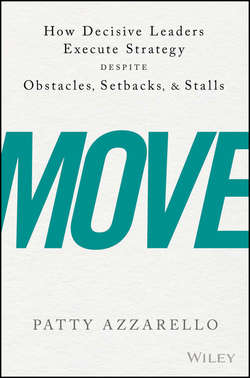Читать книгу Move - Azzarello Patty - Страница 9
На сайте Литреса книга снята с продажи.
INTRODUCTION
WHY GREAT STRATEGIES AND CHANGE INITIATIVES FAIL
MOVE
ОглавлениеThe MOVE model is the useful shorthand for the four key elements of a successful business transformation. It defines the four steps for how you get and keep your whole organization moving forward and not asking, “Are we still doing this?”
M Is for the Middle
Strategies are often stated in end goals. An end goal, no matter how inspiring it is, is not enough. The “Middle” is the important part.
A good strategy defines what you will do. What you will do describes what happens in the Middle and how you will fund, measure, and resource it. In fact, if you want to know what your strategy is, look at your budget. That will speak loud and clear about what you are actually doing regardless of what you say your strategy is.
While you are in the Middle, without the right measures that define your strategy in a concrete way, you can't know if you are making progress. And if you can't see that you are making progress, you will most likely not keep going. Everyone will stay very busy with what they are already doing, and your transformation will stall. The leaders and the team need to get fiercely aligned on the specific, clearly defined, resourced, and sponsored outcomes that need to happen throughout the Middle to bring about the long-term success of your strategy.
O Is for Organization
One of the tough things about a business transformation is that when you initially sign up to do something different, in that moment you still have the same people. Usually the new thing is bigger, more sophisticated, or more challenging in some way. One of the ways I see organizations get stuck is that they try to do the new stuff with the old people. Not everyone will be capable of what the new way requires. Not everyone will be able to step up.
Your job as a leader is not to make the best of the team you have, but to build the team you need.
Everyone in the organization needs to personally invest in understanding what is required and how they can take personal ownership to help lead the change from their roles.
V Is for Valor
This part of the model is about having the grit, persistence, and guts to stick with the change when everyone is losing confidence, questioning you, and presenting emergencies that seem more important in the moment.
As a leader, you need to demonstrate your commitment to the transformation with every decision that you make every single day.
I see too many leaders undermine their strategic initiatives and sacrifice their long-term success by overreacting to short-term pressures. This is another reason why the hard part is in the Middle. Your team will naturally be skeptical, because let's face it, so many strategic initiatives have been abandoned before. Your team will be inclined to wait it out. They may even think that it's a safer bet to wait it out than to start working on new stuff, and risk falling behind when everyone else has switched back to the old stuff. So as a leader, you need to be brave and focused and keep reinforcing decisions to move forward when everyone is tempted to go back or to abandon new work to keep reacting to short-term pressures.
E Is for Everyone
Remember, you can lead a transformation from the top, but you can't implement a transformation from the top.
Success requires everyone – not just management. Everyone. This is critical. To engage everyone requires that you fundamentally change how you think about communicating. Real engagement happens when communication is not just top-down from you, but is a conversation that involves everyone. You know you have communicated successfully when you are not the only one talking about it! People need to see that their peers have embraced the new strategy before they will feel safe to also get on board. They need to see and feel evidence of transformation throughout the whole Middle, so they will be personally motivated to keep going.
